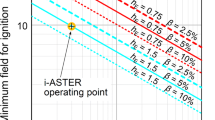Abstract
FUSION reactors based on magnetic containment and operating in a quasi steady-state will need to be refuelled during their burn period. The ballistic injection of solid pellets of hydrogen isotopes, first suggested in 19541, still seems to be the most promising method, and two satisfactory techniques for fabricating solid hydrogen pellets have been developed. In one, a continuous extrusion of solid hydrogen is thermally chopped into cylindrical pellets2. In the other, a jet of liquid hydrogen is acoustically broken into uniform droplets which are then frozen by reducing the pressure to below the triple point value3. Both techniques have worked well with deuterium, but fusion reactors will need DT pellets, and we consider here how the radioactivity of tritium will affect the situation. Two effects are apparent with characteristic times which may be short enough to be of practical significance: thermal stress arising from the deposition of decay heat throughout the pellet and electric stress caused by the charging of the pellet due to the escape of β particles from its surface. For a pellet of radius a, the thermal stress varies as a2 and the electric stress as a−2, which leads to both upper and lower size limits at radii where the effective stress approaches the yield stress of solid hydrogen. Fortunately the range of pellet radii envisaged in current reactor concepts (10−2–10−4 m) falls mid-way between the two limits.
Similar content being viewed by others
References
Spitzer, L. et al. US Atomic Energy Commission Rep. NYO-6047 (1954).
Jarboe, F. R. & Baker, W. R. Rev. Scient. Instrum. 45, 431–433 (1974).
Foster, C. A. et al. Rev. Scient. Instrum. 48, 625–631 (1977).
Carslaw, H. S. & Jaeger, J. C. Conduction of Heat in Solids (Oxford University Press, 1959).
Souers, P. C. Cryogenic Hydrogen Data Pertinent to Magnetic Fusion Energy (Lawrence Livermore Laboratory Report, in the press).
Timoshenko, S. Theory of Elasticity (McGraw-Hill, New York, 1934).
Bezuglyi, P. A. & Minyafaev, R. Kh., Soviet Phys.-Solid St. 9, 2854–5 (1968).
Bol'shutkin, D. N. et al. Soviet Phys.-Solid St. 12, 119–22 (1970).
Roder, H. M. et al. NBS Tech. Note 641 (1973).
Doyle, A. et al. J. Colloid Sci. 19, 136–43 (1964).
Schweizer, J. W. & Hanson, D. N. J. Colloid Interface Sci. 35, 417–423 (1971).
Evans, E. A. Tritium and its Compounds 2nd edn, ch. 1 (Butterworths, London 1974).
Flagg, R. F. Proc. Fusion Fuelling Workshop, 123–130 (US Department of Energy, CONF-771129, 1978).
Author information
Authors and Affiliations
Rights and permissions
About this article
Cite this article
DAVENPORT, P. Auto-irradiation effects in DT pellets. Nature 278, 236–238 (1979). https://doi.org/10.1038/278236a0
Received:
Accepted:
Issue Date:
DOI: https://doi.org/10.1038/278236a0
- Springer Nature Limited
This article is cited by
-
Rview of pellet fueling
Journal of Fusion Energy (1981)





